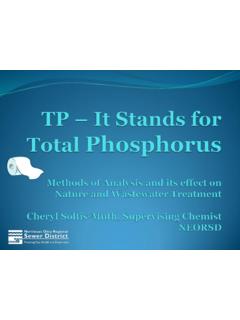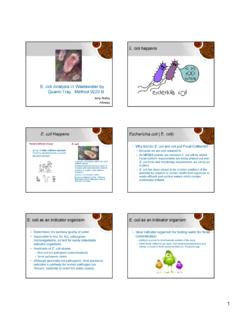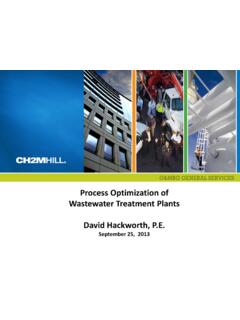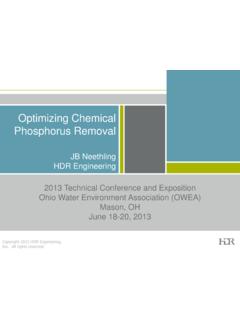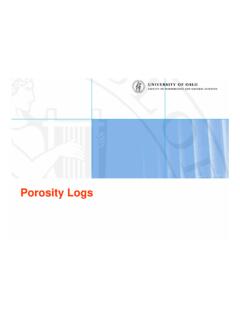Transcription of How are your CBOD’s - Ohio Water Environment …
1 how are your cbod s tips, tricks and troubleshooting Denise L Seman Youngstown WWTP CBOD s: The test we love to hate Assumed by many to be an easy test Many variables in performing this test Too many things that can go wrong CBOD basics Carbonaceous Biochemical Oxygen Demand Measures the potential of wastewater (and other waters) to deplete the oxygen level of the receiving waters CBOD is a subset of BOD BOD looks at both carbonaceous and nitrogenous biochemical oxygen demand It can be used to monitor plant operating efficiency by determining percent removal of BOD/CBOD between influent and effluent streams CBOD test is frequently used to determine the extent a waste stream will contaminate/ pollute a receiving stream by depriving the organisms in the stream of oxygen Unfortunately, the BOD/ CBOD test is the ONE test that is most likely to generate invalid data if adequate precautions aren t taken to ensure the quality of the test Samples are prepped with dilution Water to prevent total depletion of oxygen over the 5 day incubation period Nutrients are added to simulate the Environment of a receiving stream 5 days is the designated time.
2 Which allows for about 60 to 70% of available material to be consumed CBOD Trivia The reason for 5 days is supposed to be the length of time it took for Water from the river Thames to flow from London to the ocean This was established by the Royal Commission on Sewage Disposal in 1908 The US determined that at 5 days between 60 and 70% of total BOD was exerted during the incubation after investigating incubations of 1, 2, 5, 10 and 20 days. CBOD will never be higher than BOD CBOD can be equal to BOD if there is no nitrogenous uptake of oxygen There is a correlation between COD and BOD. You can use this determine dilution ranges on new sample sites To determine CBOD range from COD Lowest dilution: (2/ COD value of sample) * 300 Highest dilution: (5/COD value of sample) * 300 This gives a beginning range to set up with Method Approval Standard Methods 5210 B 2001 Includes use of optical and luminescence DO technology Samples are 5 days, not 4 or 6 and adjusted Pretreat samples if pH isn t between and (dilute H2SO4 or NaOH).
3 If pretreated, final pH should be between 7 and Pretreat samples so temp. is 20+/- 3C Adjust sample DO down if supersaturated (shake or bubble if DO of sample is greater than 9 mg/L) Remove any residual chlorine Chlorine will usually dissipate upon standing for 1 to 2 hours) If necessary, perform a titration with Na2SO3 to determine required amount needed to remove chlorine. DO NOT ADD TO EXCESS!! Dilution Water Distilled, tap or receiving Water Free of metals and toxic substances Deionized Water may contain microorganisms and organics, making it unsuitable for dilution Water DO of dilution Water should be at least Glass is preferred container for storage/ prep of dilution Water Add 1 mL each of phosphate buffer, Magnesium sulfate, Calcium chloride, and ferric chloride per liter of dilution Water Temperature should be 20 +/- 3 C Prepare dilution Water immediately before use unless blanks show Water is stable if held longer Do NOT add oxidizing agents or expose dilution Water to UV light in order to bring depletion into range Seed Preparation Preferred seed is obtained from a biological treatment system processing the waste Synthetic seed may be used if there is no viable option of a natural seed source Do not filter seed source Do not use chlorinated streams as a seed source Supernate from settled domestic wastewater, primary effluent, diluted mixed liquor are all acceptable sources of seed Seed uptake should be between and mg/L to allow for seeded samples to fall into the take 2, leave 1 range Seed controls should be run for every set of BOD/ CBOD Ideally.
4 There should be 3 seed control bottles, but at minimum no less than 2 in order to get an accurate seed value for the run Sample Prep Bring samples to 20 +/- 3C before making dilutions Check pH of sample If sample s pH is outside the range of to , adjust with sulfuric acid or sodium hydroxide to a pH of to Always seed samples that have pH adjusted When making dilutions, sample volume should not be less than 1% of bottle volume If you are using the most common size BOD bottle, it is 300 mL. Therefore, the amount of sample you use to make dilutions cannot be less than 3 mL You may need to do a serial dilution to accomplish lower values Quality Control Only bottles that give a minimal depletion of 2 mg/L and have a residual of at least mg/L DO can be calculated GGA is used to determine accuracy and precision of the BOD and should be included with every batch of samples.
5 Seed control check should be 3 bottles, different dilutions so as to allow the smallest dilution to show an uptake of 2 mg/L and the largest to have a mg/L residual. These should be included with every batch Blank check is used to monitor the dilution Water quality and should be set up with every batch of samples as well. If your blanks fail, your test data is invalid. Data may be reported out, with a qualifying statement explaining the blank failed. Data is still invalid, and corrective MUST be taken Tips & Tricks Always start with clean glassware Make sure the bod bottles, dilution Water bottle and pipettes are scrupulously clean Don t use plastic carboy for dilution Water . Plastic leaches into Water , and the valve is a breeding ground for bacteria Make sure you transfer seed, sample and dilution Water to bottles without introducing air.
6 Ideally, prep 3 bottles for each sample to allow for a variety of uptakes per site Not all 3 need to meet the take 2, leave 1 rule for valid results. Make sure to add nutrient to bottles where there is little to no dilution Water present If sample volumes are between 150 to 200 mL, add mL of each nutrient directly to the bod bottle If sample volumes are between 200 to 250 mL, add mL of each nutrient directly to the bod bottle If sample volumes are between 250 to 300 mL, add mL of each nutrient directly to each bod bottle Make sure the DO probe is calibrated correctly Rinse the probe between every bottle Allow the probe to stabilize before recording the reading Make sure dilution Water is stable, with a good pH and DO Samples are incubated for 5 days +/- 6 hours Troubleshooting Final DO of blank higher than initial DO.
7 Check on calibration techniques Check to see if samples are incubating in dark if too much light gets in, photosynthesis can occur and drive final DO higher. Was the dilution Water supersaturated? Were bubbles introduced into blank when prepping it? Too much uptake on blank DO: If there is greater than mg/L uptake for blank sample, check the following items: Check calibration techniques Are you using the same method every time? If air calibrating, is there a chart showing specific values for each barometric reading? If air calibrating is barometer set for real altitude, not corrected to sea level? Check stability of Water Are you storing it, and if how long? Do you make it up fresh? When do you add your nutrients? Check quality of source Water Do you use tap Water , distilled, deionized? Do you use receiving stream Water ?
8 Where do you get it from? Is the system clean? Check cleanliness of Water storage container Check transfer tubing, etc for possible contamination Check cleanliness of BOD bottles GGA: Glucose- glutamic acid 6 mL solution to 300 mL BOD bottle Average value is 198 mg/L Variance is mg/L Range: mg/L to mg/L According to EPA/ NELAC interpretation papers, every lab should determine their own GGA values Find the mean and standard deviation of the GGA, use these to determine the actual acceptable range for your lab your GGA prep, seed, equipment, technician(s) LOW GGA: Often occurs when using synthetic seed GGA might be old make fresh if you see values dropping off High GGA: Failed to add nitrification inhibitor Inhibitor is old Dispenser doesn t add correct amount TCMP 3 mg per 300 mL BOD bottle ATU mL per 300 mL BOD bottle NOTE.
9 ATU (Allylthiourea) is an alternate form of nitrification inhibitor As a liquid, it goes into solution quickly Not always effective during the 5 day incubation period Added in excess can create false high CBOD results TCMP: 2-chloro-6-(trichloromethyl) pyridine Doesn t dissolve well Most commercial preparations aren t pure TCMP, allowing them to go into solution better High GGA: Bottles may be overseeded. Try setting up the GGA with smaller volumes of seed CBOD value decreasing as sample volume increases: Most likely toxicity of sample occurring, killing/ impairing the seed Do more than 3 dilutions on next sample to verify. REMEMBER: Only 1 of the dilution series for each sample has to meet the take 2, leave 1 rule for valid results for the test CBOD Math BOD/CBOD - unseeded (D1 D2) P D1 = initial DO D2 = final DO P = decimal volumetric fraction of sample used Unseeded, slightly easier (Initial DO Final DO) * 300 Volume of sample Seeded: (D1 D2) ((S1 S2)SF) P D1 = initial DO of sample D2 = final DO of sample S1 = initial DO of seed S2 = final DO of seed SF = seed factor P = decimal volumetric fraction of sample used Better: (D SFC) * 300 sample volume D = sample uptake (initial DO final DO) SFC = average mg/L uptake of the good seed bottles, times mL of seed in sample bottle Remember.
10 If uptake is less than for the bottle, don t use that value If final DO is less than , don t use that value If dilution set shows non-linear values, don t report the results If the BOD values get lower as the sample volume increases, report value from smallest volume(toxicity). Set the sample site above up with lower dilutions to verify toxic effect Set up matrix spike, and spike dup to meet QC requirements Matrix spike can show if sample has an inhibiting effect MS/MSD should be evaluated by calculating an RPD RPD: Relative Percent Difference Absolute value of difference between the dups, divided by the average of the as a percent QUIZ TIME True or False Consistently high blanks (> mg/L) can be an indication of poor quality source Water (such as distilled Water ). True. Organic material, one cause of high blanks, can be present even after distilling Water and also can be leached from deionization columns.



